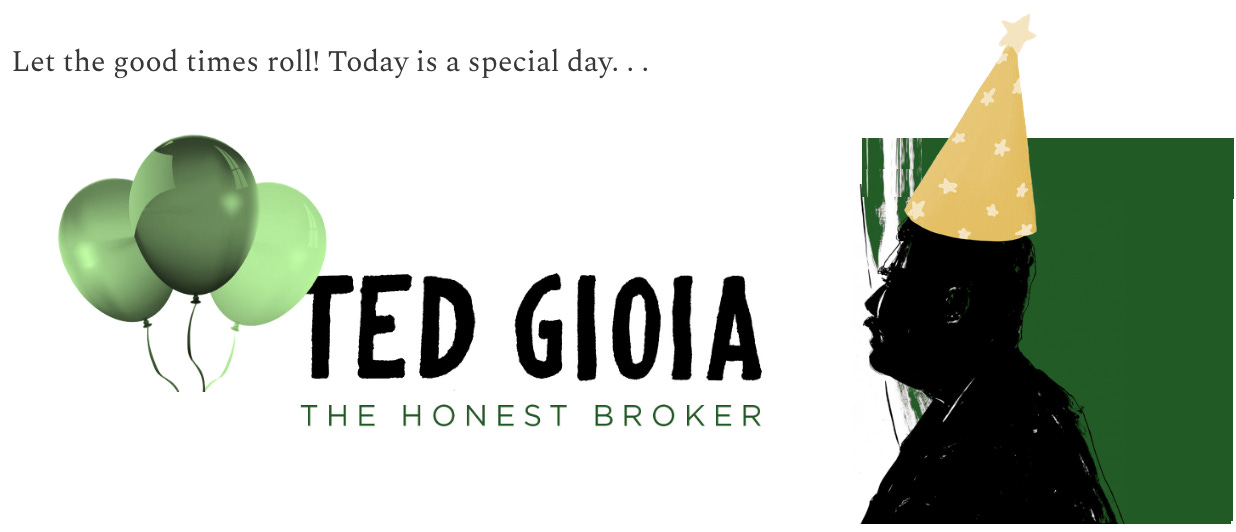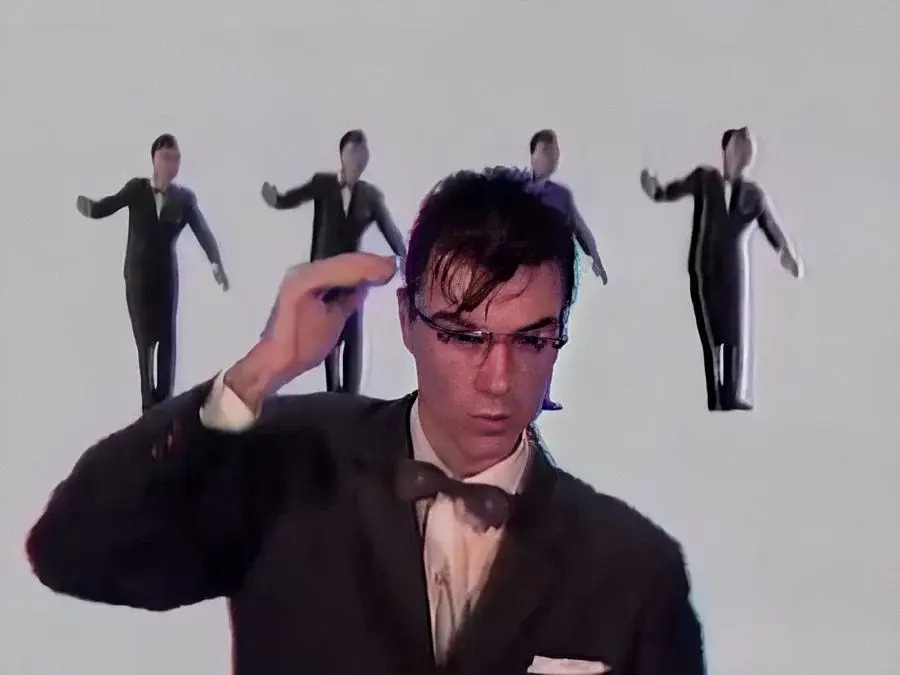Today I'm Starting My 5th Year on Substack—But Have I Learned Anything?
Thank you for joining me on this wild ride
I launched The Honest Broker on Substack four years ago today—on April 21, 2021. And it almost didn’t happen.
I’ll tell you why below. But first, let’s celebrate.
I’m wearing my party hat. I’m putting up balloons and streamers. I’m mixing up a batch of my secret party punch. We’re gonna pull out all the stops.
And you’re the guest of honor—because this only happened with your support and encouragement.
Thank you!
All of you are near and dear to me. But I want to give a special shoutout to the premium subscribers and founding members who help pay the bills here. I couldn’t operate as an honest broker in these turbulent times without your help.
And if you aren’t a premium subscriber, please consider becoming one.
There are all sorts of benefits—including access to more than 500 paywalled articles, as wells as future updates, reviews, rants, best-of-year lists, and other perks.
Above all, you get the satisfaction of supporting frank and unfiltered reporting on arts, culture, media, and society. We need that now more than ever.
Please support my work by taking out a premium subscription (just $6 per month—or less).
As part of the celebration, I’m launching my first ever online chat today for premium subscribers. I’ve never done this before on any platform—but this is a milestone moment and I’m ready to try new things.
The subject of today’s chat is how to build a community on Substack. I’ll share what I’ve learned since launching back in 2021—and listen to your questions, comments, and advice.
Because we’re all in this together.
HOW DID I GET HERE?
Back in 2021, I would have told you that there were no surprises left in my career. I’d been writing on music and culture since I was a teenager—and I’d seen it all.
I’d worked with all kinds of editors and publishers and periodicals. I’d had hits and misses. I’d had ups and downs. I’d seen fire and I’d seen rain. Etc. etc.
For better or worse, my story was already written—and it was probably time to ride off into the sunset.
So I looked forward to a more low-key lifestyle. I’d sit on the veranda with a good book, a glass of wine, and rare vinyl playing in the background.
I just needed to acquire a veranda.
But I was wrong. I had a huge surprise ahead of me.
That’s because I was now going to embark on the wildest ride yet of my already unusual career. And I didn’t know it was coming.
For a start, I’d now become my own editor and my own publisher—with my own periodical. (And there’s no tougher taskmaster than that face in the mirror.)
I’d also get to take on a new role—the way Bruce Wayne gets to be Batman. Of course, I’m a little different from him. I’ve never dreamed of becoming a superhero. But I did want to step forth in my new guise as—pause for dramatic effect—the Honest Broker.
The Honest Broker is sorta like Batman. At least I like to think so—he fights for the common good and calls out malefactors. The only difference is that I don’t live in a fancy mansion—with or without veranda—or have a butler or drive a cool Batmobile.
But doesn’t it feel like we’ve all been living in Gotham City for a long time now? Don’t we all have certain cape-and-cowl responsibilities?
Finally (and best of all), I was now going to have a closer relationship with readers than ever before. That was the thing I missed most about my career switch from musician to writer—the direct contact with an audience.
I’d now get it back.
But back in 2021, I didn’t think it was possible for an author to enjoy that direct and immediate connection with readers. But in this crazy new medium of Substacking, it absolutely is.
I was about to learn all this firsthand.
Substack’s Dan Stone (a longtime family friend) first suggested I join the platform back in 2020. By pure coincidence, I’d just subscribed to my first Substack the previous week—so I already knew about the platform.
I told Dan that I’d be a reader of Substacks, and even a paid subscriber. But I had no intention of writing one myself.
I was enjoying the good life. I was happy and living large. My books were selling well, and I had other interesting freelance opportunities.
So why join an unproven new venture?
But Dan is persistent and persuasive. So a few weeks later he made a second pitch—selling me again on the benefits of life on Substack.
I told him I’d think it over. And—to be honest—I did like the idea of being my own editor.
I’ve often battled with editors over the years—especially whenever I wanted to write about any subject besides jazz.
I thought my track record should entitle me to a little more freedom, but the opposite happened. The publishing world got more inflexible over time. With each passing year, editors became more cautious and risk averse.
I actually had an easier time with editors when I was young and unknown. Go figure! But the more success I enjoyed, the more they wanted me to march to their beat.
I don’t think this has anything to do with me—the whole media industrial complex has lost its mojo over the last 25 years, and I was just another casualty. But I felt totally worn out from battling with the publishing establishment.
That made me an obvious candidate for Substack.
But I was still afraid of the demands of launching and running a newsletter. Could I really publish consistently, and build a following?
I spent weeks agonizing over the question. I couldn’t make up my mind.
And then I caught COVID.
My COVID case wasn’t terrible. But it did leave me feeling drained and exhausted—which is unusual for me. The virus definitely knocked me off my game.
That made launching a Substack seem impossible. So, while recovering, I made the decision to decline Dan’s invitation for a second time
I sat down with my family over dinner one night, and told them my verdict—because we always talk about these things over dinner at our home.
My little speech went something like this:
I like what Substack is doing, and I’m absolutely convinced it will have a positive impact on the culture. I believe that their publishing model is the way of the future.
But I don’t like doing anything unless I do it well. And the work involved in creating a successful newsletter is huge. I would need to stop all my other projects, and just focus on Substack.
I’d need to publish regularly. I’d need to maintain constant focus and intensity—day after day, week after week, month after month.
And I don’t see that happening.
Frankly, I’m not that ambitious. Family and quality of life are more important to me than career success.
At my age, I should be thinking about cutting back—not ramping up. And it doesn’t help that I feel so exhausted from COVID.
So I’m not going to do it. Substack will flourish—I’m certain of that—but it will flourish without me.
That was my speech. And I delivered it with conviction. End of story.
But it wasn’t the end of the story.
That’s because my smart wife Tara pushed back. She rarely tells me how to manage my career—but this time she did.
Here’s what she said:
You’re only saying this because COVID has drained your energy. But I know that you have always wanted more freedom as a writer—and I’m certain you would flourish in an environment where you had that freedom.
It’s not a question of ambition. It’s about happiness. You would enjoy doing this.
So don’t be hasty in walking away from this. Take a few more days to think about it. Let your body rest up and recover—and then make a decision.
As always, Tara was right.
A few days later, I felt back to 100%. And now the idea of doing something different—more open-ended and flexible—with an entirely new publishing business model seemed like the obvious move for me.
I also thought this might really be my calling—discovered late in life. But better late than never.
That’s because, at this stage in my life, my main goal is to have a positive impact as part of a community. Maybe Substack would be my pathway for doing that.
But could I actually write multiple articles every week?
There was only way to find out. I created a workplan for a full year of Substack articles.
This meant that I needed to come up with more than 100 article ideas. Was that even possible?
I spent many days creating this workplan. And when I was finished it looked like this:
I stared at this spreadsheet for a long, long time. It’s one thing to make a plan—but turning it into a reality is a thousand times harder.
I now had doubts all over again. But I decided to spend the next month working on some of these essays and articles. I wanted to see how efficiently I could operate—but I especially wanted to find out if doing this felt energizing—or exhausting.
As the month of preparation proceeded, I found myself getting more and more excited. And even as I finished drafts of these articles, I came up with more ideas for other articles.
I could now see that operating as my own editor and publisher was intensely liberating. I was absolutely certain now that I wanted to push ahead and make this a reality.
There was only one missing piece of the puzzle—namely you.
Could I connect directly with my reader? Would we vibe together?
Well, there was only one way to find out. I had to launch this ship, and see if she sailed.
That happened four years ago today.
That was a million words ago—or, to be specific, 654 articles. During this period, our community has grown more than I ever imagined possible. We now have 235,000 members. I find that hard to believe.
And I still have a long list (100 plus) of future articles I want to write. (That’s what happens when you’re a journalist living in Gotham City—there’s never a shortage of stories.)
I also think that I should probably take advantage of Substack capacities I’ve ignored in the past—like chat or video or whatever.
If you have suggestions, let me know in the contents.
That’s because we’re still in this together. So let’s keep going, and see what we can do.





Congrats Ted! You were one of the first Substacks I subscribed to. Gotham appreciates you.
Happy Stackaversary, Ted!